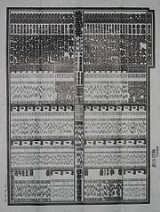
Glossary of sumo terms
Encyclopedia
The following words are terms used in sumo
wrestling in Japan. azukari (預り): Hold. A kind of draw. After a mono-ii, the gyōji
azukari (預り): Hold. A kind of draw. After a mono-ii, the gyōji
or the shimpan
"holds" the result if it was too close to call. In 1927, the system was abolished and a torinaoshi (rematch) now takes place instead.
banzuke
(番付): List of sumo wrestlers according to rank for a particular grand tournament, reflecting changes in rank due to the results of the previous tournament. It is written out in a particular calligraphy (see sumō-ji) and released two weeks prior to the tournament.
banzuke-gai (番付外): Outsider to the list. A wrestler who is not yet ranked, or has fallen off the banzuke due to injury or other reason for non-participation.
basho (場所): Venue. Any sumo tournament. Compare honbasho.
chankonabe
(ちゃんこ鍋): A stew commonly eaten in vast quantity by sumo wrestlers as part of a weight gain diet. It contains dashi
or stock with sake or mirin
to add flavor. The bulk of chankonabe is made up of large quantities of protein sources, usually chicken, fish (fried and made into balls), tofu, or sometimes beef; and vegetables (daikon, bok choy, etc.).
chikara-mizu (力水): Power-water. The ladleful of water with which a wrestler will ceremonially rinse out his mouth prior to a bout, handed to him by either the victorious wrestler of the previous bout if he was on the same side of the dohyō, or by the wrestler who will fight in the bout following.
chonmage
(丁髷): Traditional Japanese haircut with a topknot, now only worn by rikishi and so an easy way to recognize that a man is in the sumo profession.
danpatsu-shiki (断髪式): Retirement ceremony, held for a top wrestler in the Ryogoku Kokugikan
some months after retirement, in which his chonmage
, or top knot is cut off. A wrestler must have fought as a sekitori
in at least 30 tournaments to qualify for a ceremony at the Kokugikan.
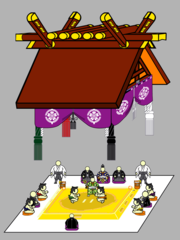 dohyō
dohyō
(土俵): The ring in which the sumo wrestlers hold their matches, made of a specific clay and spread with sand. A new dohyō is built prior to each tournament.
dohyō-iri (土俵入り): Ring-entering ceremony, performed only by jūryō and makuuchi divisions. The east and west sides perform their dohyō-iri together, in succession; the yokozuna have their own individual dohyō-iri performed separately. The main styles of yokozuna dohyō-iri are Unryū and Shiranui, named after Unryū Kyūkichi
and Shiranui Kōemon
. A yokozuna performs the ceremony with two attendants, the tachimochi
(太刀持ち, sword carrier) and the tsuyuharai
(露払い, dew sweeper).
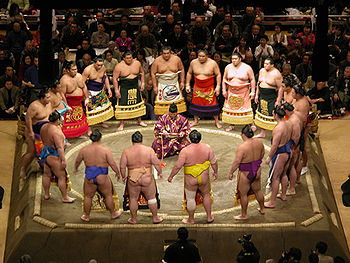
 fusenpai (不戦敗): No fight loss. The loss recorded by default due to absence for a bout. If a wrestler withdraws from the tournament, one fusenpai will be recorded against him on the following day, and simple absence for the remainder.
fusenpai (不戦敗): No fight loss. The loss recorded by default due to absence for a bout. If a wrestler withdraws from the tournament, one fusenpai will be recorded against him on the following day, and simple absence for the remainder.
fusenshō (不戦勝): No fight win. A win by default due to absence of the opponent. The system was established for the honbasho
in the May 1927 tournament. After the issue of Hitachiiwa Eitarō
, the system was modified to the modern form. Prior to this, an absence would simply be recorded for both wrestlers, regardless of which one had failed to show.
gunbai
(軍配): A war fan, usually made of wood, used by the gyōji to signal his instructions and final decision during a bout. Historically, it was used by samurai officers in Japan to communicate commands to their soldiers.
gunbai-dori (軍配通り): The decision following a mono-ii affirming the gyōji's original decision. Literally, "according to the gunbai".
gyōji
(行司): A sumo referee.
gyōji gunbai sashichigae (行司軍配差し違え): The decision following a mono-ii reversing the gyōji's original decision. Literally, "referee pointed the gunbai incorrectly".
hakkeyoi (はっけよい): The phrase shouted by a sumo referee during a bout, specifically when the action has stalled and the wrestlers have reached a stand-off. It means, "Put some spirit into it!"
hanamichi (花道): The two main east and west "paths" leading from the preparation rooms to the dohyō
.
haridashi (張り出し): Overhang. If there are more than two wrestlers at any san'yaku rank, the additional wrestlers are termed haridashi. Prior to 1995, such wrestlers were listed on the banzuke in extensions or "overhangs" to the row for makuuchi wrestlers. This is now an informal designation, since presently all wrestlers are listed within the normal bounds of the row.
henka (変化): A sidestep to avoid an attack. If done, it is usually at the tachi-ai to set up a slap-down technique, but this is often regarded as bad sumo and unworthy of higher ranked wrestlers. Some say it is a legitimate "outsmarting" move, and provides a necessary balance to direct force, "henka" meaning "changing; to change".
heya
(部屋): Room, but usually rendered stable. The establishment where a wrestler trains, and also lives while he is in the lower divisions. It is pronounced beya in compounds, such as in the name of the stable. (For example, the heya named Sadogatake is called Sadogatake-beya.)
hikiwake (引分): Draw. It is very rare now.
hiwaza (非技): Non-technique. A winning situation where the victorious wrestler did not initiate a kimarite. The Japan Sumo Association recognizes five hiwaza. See kimarite for descriptions.
honbasho
(本場所): A professional sumo tournament, held 6 times a year in the modern era, where the results affect the wrestlers' rankings.
ichimon (一門): A group of related heya
. There are five groups: Dewanoumi, Nishonoseki, Takasago, Tokitsukaze and Tatsunami. Until 1965, wrestlers from the same ichimon did not fight each other in tournament competition.
jōi-jin (上位陣): High rankers. A term loosely used to describe wrestlers who would expect to face a yokozuna during a tournament. In practice this normally means anyone ranked maegashira 4 or above.
jonidan (序二段): The second-lowest division of sumo wrestlers, below sandanme and above jonokuchi.
jonokuchi (序の口): An expression meaning this is only the beginning. The lowest division of sumo wrestlers.
junyūshō (準優勝): An informal designation for a second place finish in a sumo championship.
jūryō (十両): Ten ryō
, for the original salary of a professional sumo wrestler. The second-highest division of sumo wrestlers, below makuuchi and above makushita, and the lowest division where the wrestlers receive a salary and full privileges.
kachi-koshi (勝ち越し): More wins than losses for a wrestler in a tournament. This is 8 wins for a sekitori with 15 bouts in a tournament, and 4 wins for lower-ranked wrestlers with 7 bouts in a tournament. Gaining kachi-koshi generally results in promotion. The opposite is make-koshi.
kadoban (角番): An ōzeki who has suffered make-koshi in his previous tournament and so will be demoted if he fails to score at least eight wins. The present rules date from July 1969 and there have been over 100 cases of kadoban ozeki since that time.
kenshō-kin (懸賞金): Prize money based on sponsorship of the bout, awarded to the winner upon the gyōjis gunbai. The banners of the sponsors are paraded around the dohyō prior to the bout, and their names are announced. Half the sponsorship fees go to the Japan Sumo Association, and half to the winner.
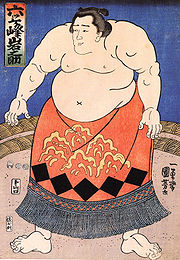 keshō-mawashi (化粧廻し): The loincloth fronted with a heavily decorated apron worn by sekitori wrestlers for the dohyō-iri. These are very expensive, and are usually paid for by the wrestler's organization of supporters or a commercial sponsor.
keshō-mawashi (化粧廻し): The loincloth fronted with a heavily decorated apron worn by sekitori wrestlers for the dohyō-iri. These are very expensive, and are usually paid for by the wrestler's organization of supporters or a commercial sponsor.
kimarite
(決まり手): Winning techniques in a sumo bout, announced by the referee on declaring the winner. The Japan Sumo Association recognizes eighty-two different kimarite.
kinboshi (金星): Gold star. Awarded to a maegashira who defeats a yokozuna during a honbasho. It represents a permanent salary bonus.
kinjite
(禁じ手):Forbidden hand. A foul move during a bout, which results in disqualification. Examples include punching, kicking and eye-poking. The only kinjite likely to be seen these days (usually inadvertently) is hair-pulling.
komusubi (小結): Little knot. The fourth-highest rank of sumo wrestlers, and the lowest san'yaku rank.
kōshō seido (公傷制度):Public Injury System. Introduced in 1972, this system allowed a wrestler who had been injured in the ring during a tournament to sit out the next tournament without any effect on his rank. It was controversially abolished at the end of 2003.
kuroboshi (黒星): Black star. A loss in a sumo bout, recorded with a black circle.
kyūjō (休場): A wrestler's absence from a honbasho, usually due to injury.
maegashira (前頭): Those ahead. The fifth-highest rank of sumo wrestlers, and the lowest makuuchi rank. This rank makes up the bulk of the makuuchi division, comprising around 30 wrestlers depending on the number in san'yaku. Only the top ranks (maegashira jō'i, 前頭上位) normally fight against san'yaku wrestlers.
maezumō (前相撲): Before sumo. Unranked sumo wrestlers in their first bouts. Participation in at least one maezumō bout is required to enter the jonokuchi division for the following honbasho
.
make-koshi (負け越し): More losses than wins for a wrestler in a tournament. Make-koshi generally results in demotion, although there are special rules on demotion for ōzeki. The opposite is kachi-koshi.
makuuchi
(幕内) or maku-no-uchi (幕の内): Inside the curtain. The top division in sumo. It is named for the curtained-off waiting area once reserved for professional wrestlers during basho, and comprises 42 wrestlers.
makushita (幕下): Below the curtain. The third highest division of sumo wrestlers, below jūryō and above sandanme. Originally the division right below makuuchi, explaining its name, before jūryō was split off from it to become the new second highest division.
makushita tsukedashi (幕下付け出し): A successful amateur wrestler who is allowed to enter pro sumo at the third highest division (makushita). From 1966 until 2001 a rikishi would begin at the rank of Makushita 60, the bottom of the division. From 2001 this was raised to Makushita 15, but entry criteria were made stricter; a wrestler now has to have won one of the four major amateur titles. In the event of two victories in the same year, he can begin at Makushita 10.
mawashi
(廻し): The thick-waisted loincloth worn for sumo training and competition. Those of sekitori wrestlers are white cotton for training and colored silk for competition; lower ranks wear dark cotton for both training and competition.
mochikyūkin
(持ち給金): A system of bonus payments to sekitori
wrestlers.
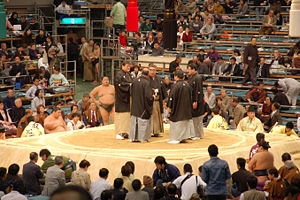 mono-ii (物言い): The discussion held by the shimpan when the gyōjis decision for a bout is called into question.
mono-ii (物言い): The discussion held by the shimpan when the gyōjis decision for a bout is called into question.
mushōbu (無勝負): No Result. A kind of draw; the gyōji
doesn't count a win or a loss. This outcome was recognised in the Edo period
.
negishi-ryū (根岸流): The conservative style of calligraphy
used in the banzuke. See sumō-ji.
nekodamashi
(猫騙し):Clapping of the hands at the tachi-ai
to distract the opponent.
Nihon Sumō Kyōkai (日本相撲協会): Japan Sumo Association
, the governing body for professional sumo.
oyakata (親方): A sumo coach, almost always the owner of one of the 105 name licenses (toshiyori-kabu, 年寄株). Also used as a suffix as a personal honorific.
ōzeki (大関): Great barrier, but usually translated Champion. The second-highest rank of sumo wrestlers.
rikishi (力士): Literally, Strong man. The most common term for a professional sumo wrestler, although sumōtori is sometimes used instead. See 力士 in Japanese.
sagari (下がり): The strings inserted into the front of the mawashi for competition. The sagari of sekitori wrestlers are stiffened with a seaweed-based glue.
sandanme (三段目): Third level. The third lowest division of sumo wrestlers, above jonidan and below makushita.
san'yaku (三役): Three ranks. The "titleholder" ranks at the top of sumo. There are actually 4 ranks in sanyaku: yokozuna, ōzeki, sekiwake and komusubi, since the yokozuna is historically an ōzeki with a license to perform his own ring-entering ceremony. The word is occasionally used to refer only to sekiwake and komusubi.
san'yaku soroibumi (三役揃い踏み): Ritual preceding the final three bouts of a honbasho day where three of the san'yaku-ranked wrestlers from the east and west sides in turn perform shiko simultaneously.
senshūraku (千秋楽): The final day of a sumo tournament.
sekitori
(関取): Taken the barrier. Sumo wrestlers ranked jūryō or higher.
sekiwake (関脇): The third-highest rank of sumo wrestlers.
shikiri (仕切り): Toeing the mark. The preparation period before a bout, during which the wrestlers stare each other down, crouch repeatedly, perform the ritual salt-throwing, and other tactics to try to gain a psychological advantage.
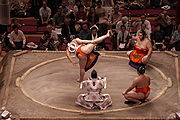 shiko (四股): The sumo exercise where each leg in succession is lifted as high and as straight as possible, and then brought down to stomp on the ground with considerable force. In training this may be repeated hundreds of times in a row. Shiko is also performed ritually to drive away demons before each bout and as part of the yokozuna dohyo-iri.
shiko (四股): The sumo exercise where each leg in succession is lifted as high and as straight as possible, and then brought down to stomp on the ground with considerable force. In training this may be repeated hundreds of times in a row. Shiko is also performed ritually to drive away demons before each bout and as part of the yokozuna dohyo-iri.
shikona
(四股名): A wrestler's "fighting name", often a poetic expression which may contain elements specific to the wrestler's heya. Japanese wrestlers frequently do not adopt a shikona until they reach makushita or jūryō; foreign wrestlers adopt one on entering the sport. On rare occasions, a wrestler may fight under his original family name for his entire career.
shimpan
(審判): Ringside judges or umpires who may issue final rulings on any disputed decision. There are five shimpan for each bout, drawn from senior members of the Nihon Sumō Kyōkai, and wearing traditional formal kimono.
shimpan-iin (審判委員): Umpire committee. The shimpan as a group.
shin-deshi (新弟子): New pupil. A new recruit into sumo.
shini-tai
(死に体):Dead body. A wrestler who was not technically the first to touch outside the ring but is nonetheless ruled the loser, for example when he is pushed out with such force that he is still in the air when his opponent touches down.
shiroboshi (白星): White star. A victory in a sumo bout, recorded with a white circle.
 shishō (師匠): Master, teacher. A sumo elder
shishō (師匠): Master, teacher. A sumo elder
in charge of a sumo stable
.
sōridaijin-hai (総理大臣杯): Prime Minister's Cup. Ceremonial cup presented by the sitting Prime Minister or an intermediary to the makuuchi champion at every tournament held in Ryogoku.
sumō-ji (相撲字): Calligraphy style with very wide brushstrokes used to write the banzuke.
 sumō moji
sumō moji
(相撲文字): See sumō-ji.
sumōtori (相撲取): Literally, One who does sumo. Sumo wrestler, but occasionally refers only to sekitori.
tachi-ai
(立ち合い): The initial charge at the beginning of a bout.
tawara (俵): Bales of rice straw. Tawara are half-buried in the clay of the dohyō to mark its boundaries.
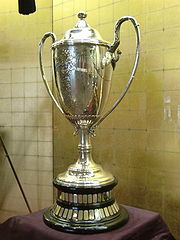
 tegata (手形): A type of memorabilia consisting of a wrestler's handprint in red or black ink and his shikona written by the wrestler in calligraphy on a square paperboard. It can be an original or a copy. A copy of a tegata may also be imprinted onto other memorabilia such as porcelain dishes.
tegata (手形): A type of memorabilia consisting of a wrestler's handprint in red or black ink and his shikona written by the wrestler in calligraphy on a square paperboard. It can be an original or a copy. A copy of a tegata may also be imprinted onto other memorabilia such as porcelain dishes.
tennō-hai (天皇杯):Emperor's Cup, awarded to the winner of the top division tournament championship since 1925.
tokoyama
(床山): Hairdressers employed by the Sumo Association to style the hair of sekitori wrestlers into the elaborate ōichomage
for official tournaments and public engagements.
torikumi (取組): A bout during a basho. May also refer to a day's bout schedule.
torinaoshi (取り直し): A rematch. When the result of a bout is too close to call even after the shimpan hold a mono-ii, they may call for the bout to be refought from the tachi-ai.
toshiyori
(年寄): A sumo elder.
tsukebito (付け人):A rikishi in the lower divisions who serves as a personal attendant to a sekitori
ranked wrestler.
tsuna (綱): The heavy rope worn by the yokozuna from which that rank takes its name. It weighs about 15 kg, and is much thicker in front than where it is tied in back. Five shide
(紙垂), zig-zag paper strips symbolizing lightning, hang from the front. It strongly resembles the shimenawa
used to mark sacred areas in Shinto
.
tsuppari: Thrusting sumo, one of the sports' two principal styles. Includes such popular kimarite
as Oshidashi, Oshitaoshi, Tsukidashi, and Tsukitaoshi.
yaochō (八百長): "Put-up job" or "fixed game", referring to a bout with a predetermined outcome.
yobidashi
(呼出 or 呼び出し): Announcer. General assistants at basho. They call the wrestlers to the dohyō before their bouts, build the dohyō prior to a tournament and maintain it between bouts, display the advertising banners before sponsored bouts, maintain the supply of ceremonial salt and chikara-mizu, and any other needed odd jobs.
yokozuna (横綱): Horizontal rope. The top rank in sumo, usually translated Grand Champion. The name comes from the rope a yokozuna wears for the dohyō-iri. See tsuna.
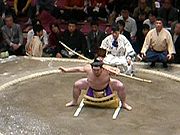 Yokozuna Shingi Kai (横綱審議会) or Yokozuna Shingi Iinkai (横綱審議委員会): Yokozuna Deliberation Council, a body formed in 1950 whose 15 members are drawn from outside the Japan Sumo Association, that meets following each honbasho to consider candidates for promotion to yokozuna. A recommendation is passed back to the Sumo Association who have the final say. It also offers opinions on the performance of current yokozuna.
Yokozuna Shingi Kai (横綱審議会) or Yokozuna Shingi Iinkai (横綱審議委員会): Yokozuna Deliberation Council, a body formed in 1950 whose 15 members are drawn from outside the Japan Sumo Association, that meets following each honbasho to consider candidates for promotion to yokozuna. A recommendation is passed back to the Sumo Association who have the final say. It also offers opinions on the performance of current yokozuna.
yumitori-shiki (弓取り式): The bow-twirling ceremony performed at the end of each honbasho day by a designated wrestler, the yumitori, who is usually from the makushita division.
yūshō
(優勝):A tournament championship in any division, awarded to the wrestler who wins the most bouts.
Sumo
is a competitive full-contact sport where a wrestler attempts to force another wrestler out of a circular ring or to touch the ground with anything other than the soles of the feet. The sport originated in Japan, the only country where it is practiced professionally...
wrestling in Japan.

Gyoji
A Gyōji is a referee in professional sumo wrestling in Japan.Gyōji usually enter the sumo world as teenagers and remain employees of the Sumo Association until they retire aged 65.-Responsibilities:...
or the shimpan
Shimpan
are the judges of a professional sumo bout. In a sumo honbasho tournament five shimpan sit around the ring to observe which wrestler wins the matchup. When judging tournament bouts they wear formal Japanese dress of otokomono, haori with mon, and hakama...
"holds" the result if it was too close to call. In 1927, the system was abolished and a torinaoshi (rematch) now takes place instead.
banzuke
Banzuke
This article is about the banzuke document, for a list of wrestlers as ranked on an actual banzuke see List of active sumo wrestlersA , officially called is a document listing the rankings of professional sumo wrestlers published before each official tournament or honbasho. The term can also...
(番付): List of sumo wrestlers according to rank for a particular grand tournament, reflecting changes in rank due to the results of the previous tournament. It is written out in a particular calligraphy (see sumō-ji) and released two weeks prior to the tournament.
banzuke-gai (番付外): Outsider to the list. A wrestler who is not yet ranked, or has fallen off the banzuke due to injury or other reason for non-participation.
basho (場所): Venue. Any sumo tournament. Compare honbasho.
chankonabe
Chankonabe
is a Japanese stew commonly eaten in vast quantity by sumo wrestlers as part of a weight-gain diet. It contains a dashi or chicken broth soup base with sake or mirin to add flavor...
(ちゃんこ鍋): A stew commonly eaten in vast quantity by sumo wrestlers as part of a weight gain diet. It contains dashi
Dashi
Dashi is a class of soup and cooking stock, considered fundamental to Japanese cooking. In 1980, Shizuo Tsuji wrote: "Many substitutes for dashi are possible, but without dashi, dishes are merely à la japonaise and lack the authentic flavor." Dashi forms the base for miso soup, clear broth, noodle...
or stock with sake or mirin
Mirin
is an essential condiment used in Japanese cuisine, consisting of 40%–50% sugar. It is a kind of rice wine similar to sake, but with a lower alcohol content—14% instead of 20%. There are three general types. The first is hon mirin , which contains alcohol. The second is shio mirin, which contains...
to add flavor. The bulk of chankonabe is made up of large quantities of protein sources, usually chicken, fish (fried and made into balls), tofu, or sometimes beef; and vegetables (daikon, bok choy, etc.).
chikara-mizu (力水): Power-water. The ladleful of water with which a wrestler will ceremonially rinse out his mouth prior to a bout, handed to him by either the victorious wrestler of the previous bout if he was on the same side of the dohyō, or by the wrestler who will fight in the bout following.
chonmage
Chonmage
The chonmage is a form of Japanese traditional haircut worn by men. It is most commonly associated with the Edo Period and samurai, and in recent times with sumo wrestlers...
(丁髷): Traditional Japanese haircut with a topknot, now only worn by rikishi and so an easy way to recognize that a man is in the sumo profession.
danpatsu-shiki (断髪式): Retirement ceremony, held for a top wrestler in the Ryogoku Kokugikan
Ryogoku Kokugikan
, also known as Sumo Hall, is an indoor sporting arena located in the Ryōgoku neighborhood of Sumida, one of the 23 wards of Tokyo in Japan, next to the Edo-Tokyo Museum. It is the third building built in Tokyo associated with the name kokugikan. The current building was opened in 1985 and has a...
some months after retirement, in which his chonmage
Chonmage
The chonmage is a form of Japanese traditional haircut worn by men. It is most commonly associated with the Edo Period and samurai, and in recent times with sumo wrestlers...
, or top knot is cut off. A wrestler must have fought as a sekitori
Sekitori
A sekitori is a sumo wrestler who is ranked in one of the top two professional divisions: makuuchi and juryo.Currently there are 70 rikishi in these divisions...
in at least 30 tournaments to qualify for a ceremony at the Kokugikan.

Dohyo
thumb|A dohyōThe dohyō is the ring in which sumo wrestling bouts are held. A modern dohyo is a circle of rice-straw bales 4.55 meters in diameter, mounted on a square platform of clay 6.7m on a side, and 34 to 60 cm high. The surface is covered by sand.A new dohyō is built prior to each...
(土俵): The ring in which the sumo wrestlers hold their matches, made of a specific clay and spread with sand. A new dohyō is built prior to each tournament.
dohyō-iri (土俵入り): Ring-entering ceremony, performed only by jūryō and makuuchi divisions. The east and west sides perform their dohyō-iri together, in succession; the yokozuna have their own individual dohyō-iri performed separately. The main styles of yokozuna dohyō-iri are Unryū and Shiranui, named after Unryū Kyūkichi
Unryu Kyukichi
Unryū Kyūkichi was a sumo wrestler from Yanagawa, Fukuoka Prefecture, Japan. He was the sport's 10th Yokozuna.-Career:...
and Shiranui Kōemon
Shiranui Koemon
Shiranui Kōemon was a sumo wrestler from Kikuchi, Kumamoto Prefecture, Japan. He was the sport's 11th Yokozuna.-Career:...
. A yokozuna performs the ceremony with two attendants, the tachimochi
Tachimochi
In professional sumo, the tachimochi is one of the two attendants that accompany a yokozuna when he performs his dohyo-iri or ring entrance ceremony. The other attendant is called the tsuyuharai....
(太刀持ち, sword carrier) and the tsuyuharai
Tsuyuharai
In professional sumo, the tsuyuharai is one of the two attendants that accompany a yokozuna when he performs his dohyo-iri or ring entrance ceremony. The other attendant is called the tachimochi....
(露払い, dew sweeper).


fusenshō (不戦勝): No fight win. A win by default due to absence of the opponent. The system was established for the honbasho
Honbasho
A is an official professional sumo tournament. There are six held each year, a system established in 1958. Only honbasho results matter in determining promotion and relegation for rikishi ....
in the May 1927 tournament. After the issue of Hitachiiwa Eitarō
Hitachiiwa Eitaro
Hitachiiwa Eitarō was a Japanese sumo wrestler from Tokyo. His highest rank was Ōzeki.-Career:...
, the system was modified to the modern form. Prior to this, an absence would simply be recorded for both wrestlers, regardless of which one had failed to show.
gunbai
Gunbai
thumb|right|A sumo gyoji wielding a gunbaiThe is a type of Japanese war fan.-Description:Gunbai were used by samurai officers in Japan to communicate commands to their troops, and were solid, not folding, and usually made of wood, wood covered with metal, or solid metal.It is also a key accessory...
(軍配): A war fan, usually made of wood, used by the gyōji to signal his instructions and final decision during a bout. Historically, it was used by samurai officers in Japan to communicate commands to their soldiers.
gunbai-dori (軍配通り): The decision following a mono-ii affirming the gyōji's original decision. Literally, "according to the gunbai".
gyōji
Gyoji
A Gyōji is a referee in professional sumo wrestling in Japan.Gyōji usually enter the sumo world as teenagers and remain employees of the Sumo Association until they retire aged 65.-Responsibilities:...
(行司): A sumo referee.
gyōji gunbai sashichigae (行司軍配差し違え): The decision following a mono-ii reversing the gyōji's original decision. Literally, "referee pointed the gunbai incorrectly".
hakkeyoi (はっけよい): The phrase shouted by a sumo referee during a bout, specifically when the action has stalled and the wrestlers have reached a stand-off. It means, "Put some spirit into it!"
hanamichi (花道): The two main east and west "paths" leading from the preparation rooms to the dohyō
Dohyo
thumb|A dohyōThe dohyō is the ring in which sumo wrestling bouts are held. A modern dohyo is a circle of rice-straw bales 4.55 meters in diameter, mounted on a square platform of clay 6.7m on a side, and 34 to 60 cm high. The surface is covered by sand.A new dohyō is built prior to each...
.
haridashi (張り出し): Overhang. If there are more than two wrestlers at any san'yaku rank, the additional wrestlers are termed haridashi. Prior to 1995, such wrestlers were listed on the banzuke in extensions or "overhangs" to the row for makuuchi wrestlers. This is now an informal designation, since presently all wrestlers are listed within the normal bounds of the row.
henka (変化): A sidestep to avoid an attack. If done, it is usually at the tachi-ai to set up a slap-down technique, but this is often regarded as bad sumo and unworthy of higher ranked wrestlers. Some say it is a legitimate "outsmarting" move, and provides a necessary balance to direct force, "henka" meaning "changing; to change".
heya
Heya
In sumo wrestling, a heya , usually translated into English as stable, is an organization of sumo wrestlers where they train and live. All wrestlers in professional sumo must belong to one. There are currently 49 heya , all but four of which belong to one of five ichimon...
(部屋): Room, but usually rendered stable. The establishment where a wrestler trains, and also lives while he is in the lower divisions. It is pronounced beya in compounds, such as in the name of the stable. (For example, the heya named Sadogatake is called Sadogatake-beya.)
hikiwake (引分): Draw. It is very rare now.
hiwaza (非技): Non-technique. A winning situation where the victorious wrestler did not initiate a kimarite. The Japan Sumo Association recognizes five hiwaza. See kimarite for descriptions.
honbasho
Honbasho
A is an official professional sumo tournament. There are six held each year, a system established in 1958. Only honbasho results matter in determining promotion and relegation for rikishi ....
(本場所): A professional sumo tournament, held 6 times a year in the modern era, where the results affect the wrestlers' rankings.
ichimon (一門): A group of related heya
Heya
In sumo wrestling, a heya , usually translated into English as stable, is an organization of sumo wrestlers where they train and live. All wrestlers in professional sumo must belong to one. There are currently 49 heya , all but four of which belong to one of five ichimon...
. There are five groups: Dewanoumi, Nishonoseki, Takasago, Tokitsukaze and Tatsunami. Until 1965, wrestlers from the same ichimon did not fight each other in tournament competition.
jōi-jin (上位陣): High rankers. A term loosely used to describe wrestlers who would expect to face a yokozuna during a tournament. In practice this normally means anyone ranked maegashira 4 or above.
jonidan (序二段): The second-lowest division of sumo wrestlers, below sandanme and above jonokuchi.
jonokuchi (序の口): An expression meaning this is only the beginning. The lowest division of sumo wrestlers.
junyūshō (準優勝): An informal designation for a second place finish in a sumo championship.
jūryō (十両): Ten ryō
Ryo
Ryo may refer to:* The Japanese kana digraph ryo, ryō, or ryoh * Ryō , a gold piece in pre-Meiji era Japan worth about sixty monme or four kan...
, for the original salary of a professional sumo wrestler. The second-highest division of sumo wrestlers, below makuuchi and above makushita, and the lowest division where the wrestlers receive a salary and full privileges.
kachi-koshi (勝ち越し): More wins than losses for a wrestler in a tournament. This is 8 wins for a sekitori with 15 bouts in a tournament, and 4 wins for lower-ranked wrestlers with 7 bouts in a tournament. Gaining kachi-koshi generally results in promotion. The opposite is make-koshi.
kadoban (角番): An ōzeki who has suffered make-koshi in his previous tournament and so will be demoted if he fails to score at least eight wins. The present rules date from July 1969 and there have been over 100 cases of kadoban ozeki since that time.
kenshō-kin (懸賞金): Prize money based on sponsorship of the bout, awarded to the winner upon the gyōjis gunbai. The banners of the sponsors are paraded around the dohyō prior to the bout, and their names are announced. Half the sponsorship fees go to the Japan Sumo Association, and half to the winner.

kimarite
Kimarite
Kimarite are winning techniques in a sumo bout. For each bout in a Grand Sumo tournament , a sumo referee, or gyoji, will decide and announce the type of kimarite used by the winner...
(決まり手): Winning techniques in a sumo bout, announced by the referee on declaring the winner. The Japan Sumo Association recognizes eighty-two different kimarite.
kinboshi (金星): Gold star. Awarded to a maegashira who defeats a yokozuna during a honbasho. It represents a permanent salary bonus.
kinjite
Kinjite
Kinjite are various fouls that a sumo wrestler might commit that will cause him to lose the bout. They are:* Striking the opponent with a closed fist.* Grabbing the opponent’s hair....
(禁じ手):Forbidden hand. A foul move during a bout, which results in disqualification. Examples include punching, kicking and eye-poking. The only kinjite likely to be seen these days (usually inadvertently) is hair-pulling.
komusubi (小結): Little knot. The fourth-highest rank of sumo wrestlers, and the lowest san'yaku rank.
kōshō seido (公傷制度):Public Injury System. Introduced in 1972, this system allowed a wrestler who had been injured in the ring during a tournament to sit out the next tournament without any effect on his rank. It was controversially abolished at the end of 2003.
kuroboshi (黒星): Black star. A loss in a sumo bout, recorded with a black circle.
kyūjō (休場): A wrestler's absence from a honbasho, usually due to injury.
maegashira (前頭): Those ahead. The fifth-highest rank of sumo wrestlers, and the lowest makuuchi rank. This rank makes up the bulk of the makuuchi division, comprising around 30 wrestlers depending on the number in san'yaku. Only the top ranks (maegashira jō'i, 前頭上位) normally fight against san'yaku wrestlers.
maezumō (前相撲): Before sumo. Unranked sumo wrestlers in their first bouts. Participation in at least one maezumō bout is required to enter the jonokuchi division for the following honbasho
Honbasho
A is an official professional sumo tournament. There are six held each year, a system established in 1958. Only honbasho results matter in determining promotion and relegation for rikishi ....
.
make-koshi (負け越し): More losses than wins for a wrestler in a tournament. Make-koshi generally results in demotion, although there are special rules on demotion for ōzeki. The opposite is kachi-koshi.
makuuchi
Makuuchi
or is the top division of professional sumo. Its size is fixed at 42 wrestlers , ordered into five ranks according to their ability as defined by their performance in previous tournaments....
(幕内) or maku-no-uchi (幕の内): Inside the curtain. The top division in sumo. It is named for the curtained-off waiting area once reserved for professional wrestlers during basho, and comprises 42 wrestlers.
makushita (幕下): Below the curtain. The third highest division of sumo wrestlers, below jūryō and above sandanme. Originally the division right below makuuchi, explaining its name, before jūryō was split off from it to become the new second highest division.
makushita tsukedashi (幕下付け出し): A successful amateur wrestler who is allowed to enter pro sumo at the third highest division (makushita). From 1966 until 2001 a rikishi would begin at the rank of Makushita 60, the bottom of the division. From 2001 this was raised to Makushita 15, but entry criteria were made stricter; a wrestler now has to have won one of the four major amateur titles. In the event of two victories in the same year, he can begin at Makushita 10.
mawashi
Mawashi
In sumo, a mawashi is the belt that the rikishi wears during training or in competition. Upper ranked professional wrestlers wear a keshō-mawashi as part of the ring entry ceremony or dohyo-iri.-Mawashi:...
(廻し): The thick-waisted loincloth worn for sumo training and competition. Those of sekitori wrestlers are white cotton for training and colored silk for competition; lower ranks wear dark cotton for both training and competition.
mochikyūkin
Mochikyukin
Mochikyūkin is a system of payment for sumo wrestlers that supplements the basic salary that sekitori earn.This bonus is calculated using a fairly complex formula. When a wrestler enters professional sumo, he is credited with 3 yen...
(持ち給金): A system of bonus payments to sekitori
Sekitori
A sekitori is a sumo wrestler who is ranked in one of the top two professional divisions: makuuchi and juryo.Currently there are 70 rikishi in these divisions...
wrestlers.

mushōbu (無勝負): No Result. A kind of draw; the gyōji
Gyoji
A Gyōji is a referee in professional sumo wrestling in Japan.Gyōji usually enter the sumo world as teenagers and remain employees of the Sumo Association until they retire aged 65.-Responsibilities:...
doesn't count a win or a loss. This outcome was recognised in the Edo period
Edo period
The , or , is a division of Japanese history which was ruled by the shoguns of the Tokugawa family, running from 1603 to 1868. The political entity of this period was the Tokugawa shogunate....
.
negishi-ryū (根岸流): The conservative style of calligraphy
Japanese calligraphy
is a form of calligraphy, or artistic writing, of the Japanese language. For a long time, the most esteemed calligrapher in Japan had been Wang Xizhi, a Chinese calligrapher in the 4th century but after the invention of Hiragana and Katakana, the Japanese unique syllabaries, the distinctive...
used in the banzuke. See sumō-ji.
nekodamashi
Nekodamashi
is an unconventional sumo wrestling technique which involves a wrestler clapping his hands together in front of his opponent's face at the tachiai The aim of this technique is to cause the opponent to close his eyes briefly, allowing the instigator to gain the advantage.Nekodamashi requires there...
(猫騙し):Clapping of the hands at the tachi-ai
Tachi-ai
The tachi-ai is the initial charge between two sumo wrestlers at the beginning of a bout.There are several common techniques that wrestlers use at the tachi-ai, with the aim of getting a decisive advantage in the bout:...
to distract the opponent.
Nihon Sumō Kyōkai (日本相撲協会): Japan Sumo Association
Japan Sumo Association
The is the body that operates and controls professional sumo wrestling in Japan under the jurisdiction of the Japanese Ministry of Education, Culture, Sports, Science and Technology. Rikishi , gyōji , tokoyama , and yobidashi , are all on the Association's payroll, but the organisation is run...
, the governing body for professional sumo.
oyakata (親方): A sumo coach, almost always the owner of one of the 105 name licenses (toshiyori-kabu, 年寄株). Also used as a suffix as a personal honorific.
ōzeki (大関): Great barrier, but usually translated Champion. The second-highest rank of sumo wrestlers.
rikishi (力士): Literally, Strong man. The most common term for a professional sumo wrestler, although sumōtori is sometimes used instead. See 力士 in Japanese.
sagari (下がり): The strings inserted into the front of the mawashi for competition. The sagari of sekitori wrestlers are stiffened with a seaweed-based glue.
sandanme (三段目): Third level. The third lowest division of sumo wrestlers, above jonidan and below makushita.
san'yaku (三役): Three ranks. The "titleholder" ranks at the top of sumo. There are actually 4 ranks in sanyaku: yokozuna, ōzeki, sekiwake and komusubi, since the yokozuna is historically an ōzeki with a license to perform his own ring-entering ceremony. The word is occasionally used to refer only to sekiwake and komusubi.
san'yaku soroibumi (三役揃い踏み): Ritual preceding the final three bouts of a honbasho day where three of the san'yaku-ranked wrestlers from the east and west sides in turn perform shiko simultaneously.
senshūraku (千秋楽): The final day of a sumo tournament.
sekitori
Sekitori
A sekitori is a sumo wrestler who is ranked in one of the top two professional divisions: makuuchi and juryo.Currently there are 70 rikishi in these divisions...
(関取): Taken the barrier. Sumo wrestlers ranked jūryō or higher.
sekiwake (関脇): The third-highest rank of sumo wrestlers.
shikiri (仕切り): Toeing the mark. The preparation period before a bout, during which the wrestlers stare each other down, crouch repeatedly, perform the ritual salt-throwing, and other tactics to try to gain a psychological advantage.

shikona
Shikona
A shikona is a sumo wrestler's ring name.As with standard Japanese names, a shikona consists of a 'surname' and a 'given' name, and the full name is written surname first. However, the given name is rarely used outside formal or ceremonial occasions. Thus, the former yokozuna Asashōryū Akinori is...
(四股名): A wrestler's "fighting name", often a poetic expression which may contain elements specific to the wrestler's heya. Japanese wrestlers frequently do not adopt a shikona until they reach makushita or jūryō; foreign wrestlers adopt one on entering the sport. On rare occasions, a wrestler may fight under his original family name for his entire career.
shimpan
Shimpan
are the judges of a professional sumo bout. In a sumo honbasho tournament five shimpan sit around the ring to observe which wrestler wins the matchup. When judging tournament bouts they wear formal Japanese dress of otokomono, haori with mon, and hakama...
(審判): Ringside judges or umpires who may issue final rulings on any disputed decision. There are five shimpan for each bout, drawn from senior members of the Nihon Sumō Kyōkai, and wearing traditional formal kimono.
shimpan-iin (審判委員): Umpire committee. The shimpan as a group.
shin-deshi (新弟子): New pupil. A new recruit into sumo.
shini-tai
Shini-tai
is a term used in sumō wrestling. In general, the first sumo wrestler to touch any body part outside the ring, or have any part of his body other than the soles of his feet touch the ground loses...
(死に体):Dead body. A wrestler who was not technically the first to touch outside the ring but is nonetheless ruled the loser, for example when he is pushed out with such force that he is still in the air when his opponent touches down.
shiroboshi (白星): White star. A victory in a sumo bout, recorded with a white circle.

Toshiyori
A toshiyori is a sumo elder of the Japan Sumo Association. Also known as oyakata, former wrestlers who reached a sufficiently high rank are the only people eligible...
in charge of a sumo stable
Heya
In sumo wrestling, a heya , usually translated into English as stable, is an organization of sumo wrestlers where they train and live. All wrestlers in professional sumo must belong to one. There are currently 49 heya , all but four of which belong to one of five ichimon...
.
sōridaijin-hai (総理大臣杯): Prime Minister's Cup. Ceremonial cup presented by the sitting Prime Minister or an intermediary to the makuuchi champion at every tournament held in Ryogoku.
sumō-ji (相撲字): Calligraphy style with very wide brushstrokes used to write the banzuke.

Edomoji
are Japanese lettering styles, which were invented for advertising in the Edo period.The main styles of Edomoji include Kanteiryū, Yosemoji, Kagomoji, Higemoji, Chōchinmoji and Kakuji .-Kanteiryū :...
(相撲文字): See sumō-ji.
sumōtori (相撲取): Literally, One who does sumo. Sumo wrestler, but occasionally refers only to sekitori.
tachi-ai
Tachi-ai
The tachi-ai is the initial charge between two sumo wrestlers at the beginning of a bout.There are several common techniques that wrestlers use at the tachi-ai, with the aim of getting a decisive advantage in the bout:...
(立ち合い): The initial charge at the beginning of a bout.
tawara (俵): Bales of rice straw. Tawara are half-buried in the clay of the dohyō to mark its boundaries.


tennō-hai (天皇杯):Emperor's Cup, awarded to the winner of the top division tournament championship since 1925.
tokoyama
Tokoyama
A tokoyama is a hairdresser employed by the Japan Sumo Association to cut and prepare sumo wrestlers' hair, which is done in a chonmage style...
(床山): Hairdressers employed by the Sumo Association to style the hair of sekitori wrestlers into the elaborate ōichomage
Chonmage
The chonmage is a form of Japanese traditional haircut worn by men. It is most commonly associated with the Edo Period and samurai, and in recent times with sumo wrestlers...
for official tournaments and public engagements.
torikumi (取組): A bout during a basho. May also refer to a day's bout schedule.
torinaoshi (取り直し): A rematch. When the result of a bout is too close to call even after the shimpan hold a mono-ii, they may call for the bout to be refought from the tachi-ai.
toshiyori
Toshiyori
A toshiyori is a sumo elder of the Japan Sumo Association. Also known as oyakata, former wrestlers who reached a sufficiently high rank are the only people eligible...
(年寄): A sumo elder.
tsukebito (付け人):A rikishi in the lower divisions who serves as a personal attendant to a sekitori
Sekitori
A sekitori is a sumo wrestler who is ranked in one of the top two professional divisions: makuuchi and juryo.Currently there are 70 rikishi in these divisions...
ranked wrestler.
tsuna (綱): The heavy rope worn by the yokozuna from which that rank takes its name. It weighs about 15 kg, and is much thicker in front than where it is tied in back. Five shide
Shide (shinto)
is a zigzag-shaped paper streamer, often seen attached to shimenawa or tamagushi, and used in Shinto rituals. A popular ritual is using a haraegushi, or "lightning wand", named for the zig-zag shide paper that adorns the wand. A similar wand, used by miko for purification and blessing, is the gohei...
(紙垂), zig-zag paper strips symbolizing lightning, hang from the front. It strongly resembles the shimenawa
Shimenawa
Shimenawa are lengths of braided rice straw rope used for ritual purification in the Shinto religion. They can vary in diameter from a few centimetres to several metres, and are often seen festooned with shide...
used to mark sacred areas in Shinto
Shinto
or Shintoism, also kami-no-michi, is the indigenous spirituality of Japan and the Japanese people. It is a set of practices, to be carried out diligently, to establish a connection between present day Japan and its ancient past. Shinto practices were first recorded and codified in the written...
.
tsuppari: Thrusting sumo, one of the sports' two principal styles. Includes such popular kimarite
Kimarite
Kimarite are winning techniques in a sumo bout. For each bout in a Grand Sumo tournament , a sumo referee, or gyoji, will decide and announce the type of kimarite used by the winner...
as Oshidashi, Oshitaoshi, Tsukidashi, and Tsukitaoshi.
yaochō (八百長): "Put-up job" or "fixed game", referring to a bout with a predetermined outcome.
yobidashi
Yobidashi
The yobidashi calls a professional sumo wrestler, or rikishi, to the dohyō immediately prior to his bout...
(呼出 or 呼び出し): Announcer. General assistants at basho. They call the wrestlers to the dohyō before their bouts, build the dohyō prior to a tournament and maintain it between bouts, display the advertising banners before sponsored bouts, maintain the supply of ceremonial salt and chikara-mizu, and any other needed odd jobs.
yokozuna (横綱): Horizontal rope. The top rank in sumo, usually translated Grand Champion. The name comes from the rope a yokozuna wears for the dohyō-iri. See tsuna.

yumitori-shiki (弓取り式): The bow-twirling ceremony performed at the end of each honbasho day by a designated wrestler, the yumitori, who is usually from the makushita division.
yūshō
Yusho
A Yūshō is a tournament championship in sumo. It is awarded in each of the six annual honbasho or official tournaments, to the wrestler who wins the most number of bouts. Yūshō are awarded in all six professional sumo divisions...
(優勝):A tournament championship in any division, awarded to the wrestler who wins the most bouts.

